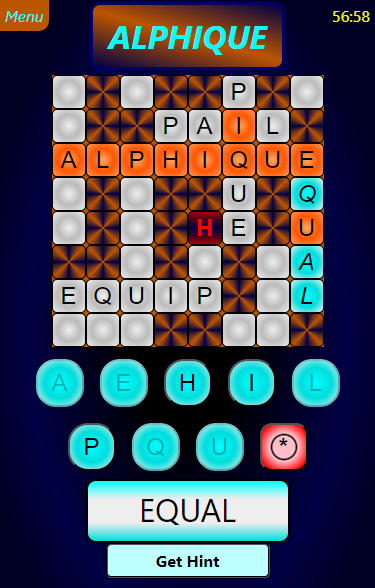How to Play

- Tap the letter buttons to spell out a word
- Possible locations highlight on the grid
- To add the word, tap the highlighted grid cells
- If only one place is highlighted, you can add by tapping the word box
- Tapping the red circle button clears out the word
- Hints identifying bad letters or words can be removed by tapping them or submitting the next word
- To remove a word, tap it. If the other orientation is desired tap it again. Then tap the red circle button.
Goal of the Game
As you can probably guess, the goal of the game is to fill in each empty box with a letter. Doing so is not as easy as it looks, as each row and column can only have each letter once. There's unique alpha(bet) characters - you could say it's Alphique. Likewise, words, acronyms, and abbreviations are spelled out reading left to right and top to bottom (like any crossword puzzle). You are scored by solving it quickly, with minimal hints, and minimal letter/word submissions. Low scores are good.
User Entry
The recommended way to play the game is to use the blue buttons as a keyboard. Those are the only letters you are allowed to use, and as you type out a word, they'll disable to prevent entering in duplicate letters. As you type in a word, the grid will show all the different places it can fit on the board in light blue. To add it to the board, you can either tap the highlighted position on the board, or if there is only one entry, you can tap the typed out word in the blue box.
The poor scoring methodology to play the game is to enter in letters individually. You may tap each cell to highlight it, and then the blue buttons will disable appropriately based on letter uniqueness. Tapping a letter button will then enter it into the cell. Each letter entered this way is worth a point. If you enter a full word, it is worth a point. Points are bad. However, it is good practice to select a cell to easily determine what letters can go there. It is a lot easier to come up with a word when you narrow down particular positions to be one or two letters.
The red button shown is a clear button. It's used to clear out the word typed without adding it, or remove unconfirmed things from the board. There is another button that is not pictured in the image. That is an older UI, but there's a back button now. It duplicates some of the clear functionalities, but it's primary purpose is to remove the last letter typed.
The Word Entered Box
Directly above the "Get Hint" button is a blue and white box that shows the current word being spelled out. Any time you tap that, it clears out the word typed. In the event that there is only space it fits on the board, it will automatically add it. This is meant to enable your thumbs to always stay near the lower portion of your phone when playing, as that is simply ergonomically easier to handle. Occasionally, the "Get Hint" button will suggest a 3 or 4 letter word, and it will show up in this box as if you typed it. That word is guaranteed to be on the board, though it may fit in multiple locations.
Removing Words
Sometimes, you realize you made a mistake. Maybe that word you entered wasn't a word. Perhaps you realized that blocks out a more obvious word. Don't worry, it can be removed. By tapping the word you want to remove, it becomes highlighted. In the event that the horizontal word was highlighted and you wanted the vertical word, tap that same cell again. Then there is the red button with the * in it, which is the clear button. Tap that and the word ought to disappear. Note, you cannot delete confirmed words or letters. You can only delete things that you entered, so removing one letter from a full word entry is not possible.Hints
There is an entire segment devoted to hints, but the quick summary is be smart. Use them to validate the game board as currently entered and get additional guaranteed letters on the board. It's very difficult to solve with just one hint per letter to start the game, and this is meant to be solvable in 15 minutes or less.
Strategies
Use hints early to fill out the board, but not excessively as they may be needed later and there are time punishments for repeated use. Because the board accepts any valid solution, but hints always point towards one solution, hints towards the end may not really provide meaningful information.
Start big, and then work your way small. Big words provide more restrictions, and there are inherently less of them that could fit in a given spot. If you fill in a 2 letter word, let's say "SI" (silicon), but the word actually was "IS", that may mean the word "SILVER" no longer fits in the spot. Instead, you may thing "SLIVER" fits there, but now the L and I are propagating incorrectly. At the end, what are largely swappable words pushed you away from the parts that are unique.
Periodically use a hint when trying to determine words just as a gut check. Multiple large words may fit in a single position when the board isn't filled out. The reason it may be so hard to find a word for a spot is because an incorrect entry was made earlier. The way you discover that the earlier word was incorrect is that you can no longer proceed with the puzzle... or just tap the hint button. That is far less frustrating.